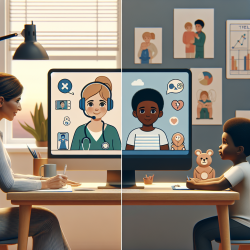Embracing Telehealth: Lessons from Veterans Affairs
As a speech-language pathologist dedicated to improving outcomes for children, it's crucial to stay informed about the latest research and technologies that can enhance our practice. The study "Patient Perceptions of Video Visits Using Veterans Affairs Telehealth Tablets: Survey Study" provides valuable insights into the efficacy and patient satisfaction associated with video-based healthcare. This research is particularly relevant for practitioners looking to integrate telehealth into their services, such as those provided by TinyEYE.
Key Findings and Their Implications
The study surveyed veterans who received video-enabled tablets from the Department of Veterans Affairs (VA) to assess their experiences with telehealth services. The results were promising: a significant portion of the participants expressed satisfaction with video visits, citing convenience and improved access to care as major benefits. Approximately two-thirds of the tablet recipients preferred video visits or found them comparable to in-person care.
For practitioners, these findings highlight the potential of telehealth to overcome traditional barriers to accessing care, such as transportation issues or discomfort in clinical settings. By leveraging video visits, practitioners can reach more clients, including those who may face challenges attending in-person sessions.
Practical Steps for Practitioners
- Assess Client Needs: Evaluate which clients might benefit most from telehealth services. Consider factors such as transportation difficulties, comfort levels with technology, and specific health conditions.
- Enhance Technical Support: Ensure that clients have access to the necessary technology and support to participate in video visits effectively. This might include providing guidance on using devices or troubleshooting connectivity issues.
- Foster Collaborative Communication: Encourage a collaborative communication style during video visits. This approach was associated with higher satisfaction levels among study participants.
- Address Technology Challenges: Be proactive in addressing any technology-related challenges that clients may face, ensuring a smooth and effective telehealth experience.
Encouraging Further Research
While the study provides valuable insights, it also opens the door for further research. Practitioners are encouraged to explore additional questions, such as how telehealth can be tailored to meet the unique needs of children in speech-language therapy. By staying engaged with ongoing research, practitioners can continue to refine and improve their telehealth offerings.
Conclusion
Integrating telehealth into speech-language pathology practice offers a promising avenue for enhancing client outcomes and expanding access to care. By drawing on the findings of this study and implementing data-driven strategies, practitioners can effectively harness the power of video visits. For those interested in delving deeper into the research, I recommend reading the original study, Patient Perceptions of Video Visits Using Veterans Affairs Telehealth Tablets: Survey Study.










